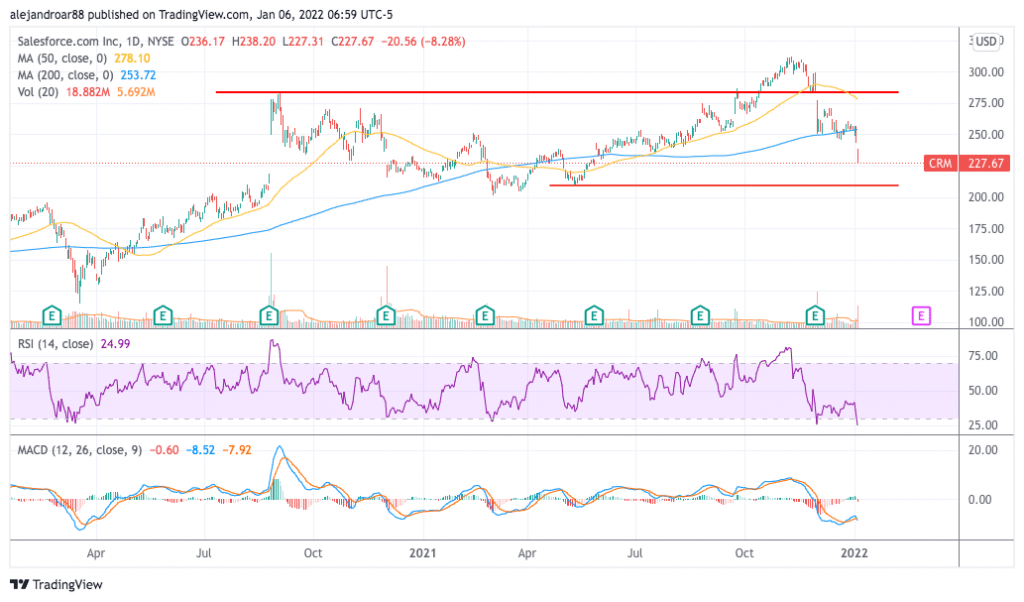Salesforce Stock Down 11% in January – Time to Buy CRM Stock?
Please note that we are not authorised to provide any investment advice. The content on this page is for information purposes only.
The price of Salesforce stock is down 11% so far this month after it was downgraded by analysts at UBS. Analysts from the Swiss bank said that they expected slower top-line growth moving forward as some of the secular trends that once lifted the performance of the company may start to fade.
“The secular trends boosting 3rd-party software spend are strong enough to at least partly offset this pull-forward/deceleration risk in 1H22”, UBS analysts stated.
However, they added: “but post these conversations we are more concerned that we are now trending to a more normalized (lower) growth rate, especially in sub-sectors such as ‘front-office/sales and marketing’ tech spend that was clearly accelerated”.
UBS further commented: “It seems likely that Salesforce’s organic growth will moderate in 2022, which may out-weigh the positive associated with the improving margin narrative”.
Salesforce stock was downgraded from buy to neutral by the investment bank and its price target was slashed from $315 to $265 per share.
Shares declined 8.3% during yesterday’s stock trading session following the 3% decline they had experienced the day before. A steep increase in US Treasury yields has also weighed on the performance of the stock in the past few weeks.
Last month, the yield of the US 10-year Treasury Note climbed from 1.45% to 1.514% while the benchmark closed much higher yesterday at 1.735% following the release of the Fed’s minutes from last month. This has been the second highest daily closing since the pandemic started and could possibly be signaling a shift in the market’s opinion about how the US central bank will handle its monetary policy moving forward.
Trading multiples of growth stocks like Salesforce may shrink in a scenario where interest rates are hiked sooner or faster than expected while officials from the central bank reportedly discussed the possibility of scaling down the institution’s balance sheet earlier than the market had anticipated.
What can be expected from this tech giant after these interesting developments? In the following article, I’ll be assessing the price action and fundamentals of CRM stock to outline plausible scenarios for the future.
67% of all retail investor accounts lose money when trading CFDs with this provider.
Salesforce Stock – Technical Analysis

In a recent article about Salesforce, I stated that the decline that followed the release of the firm’s latest earnings report would probably aim to close the 23 September price gap and that was exactly what happened during that session.
Meanwhile, I also stated that the 200-day simple moving average was the most relevant area of support to watch as a break below would be a sign of mid-term weakness for CRM.
After a few failed attempts, yesterday’s decline has broken this threshold for good and that is not good news for Salesforce investors as the next horizontal support to watch is found at the $210 level for a total 7.8% downside risk based on yesterday’s closing price.
Trading volumes were particularly high yesterday as they exceeded the 10-day average by more than 3 times.
Moreover, momentum indicators are favoring a bearish outlook as well as the Relative Strength Index (RSI) just made a lower low while the MACD has just crossed below the signal line. Also, histogram readings have turned negative and that may mark the beginning of a wave of negative momentum for Salesforce stock in future sessions.
Salesforce Stock – Fundamental Analysis
Salesforce has stated in the past few quarters that it expects to deliver 20% or higher annual revenue growth rates for the next two years at least. However, the firm’s GAAP operating margins are still expected to remain either negative or mildly positive – aiming for positive low single-digit percentages in 2023.
Even though the company has managed to grow its top-line results quite fast in the past few years, profits are still elusive and that is a factor that will continue to weigh on the firm’s valuation – especially if macro conditions become tighter.
Based on the company’s projections of $26.4 billion for its 2022 sales, Salesforce is being valued at 8.5 times that figure. That is an elevated multiple considering that the company’s operating performance is so poor.
With this in mind, the risk of an accelerated decline in the company’s valuation seems elevated at the moment.
It is important to note that even though Salesforce’s balance sheet seems strong at first glance, most of the company’s asset base is made up of goodwill and intangible items. If one takes those items off the table, total assets would land somewhere around $30 billion while the company’s long-term debt stands at $10.6 billion.
Last year, the company generated around $4.1 billion in free cash flows resulting in an FCF margin of 19.3%. Based on this year’s projections, Salesforce could produce around $5 billion in free cash flows and this results in a P/FCF ratio of 45.
Overall, the valuation of this firm seems stretched from a fundamental standpoint and, considering the possibility that macro conditions will deteriorate this year, chances are that Salesforce will continue to experience some negative volatility for the rest of the year.






